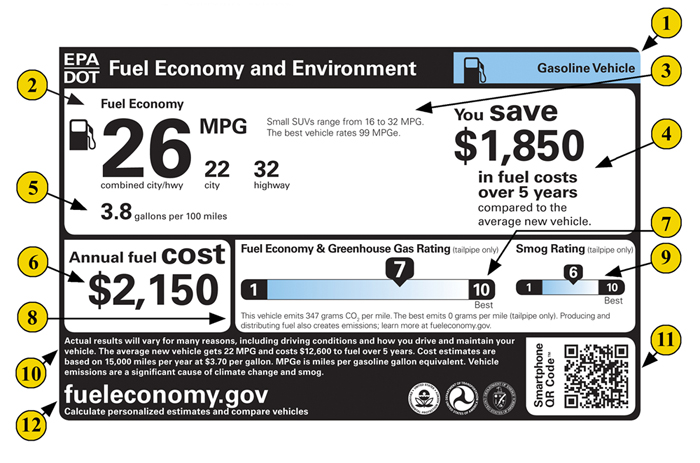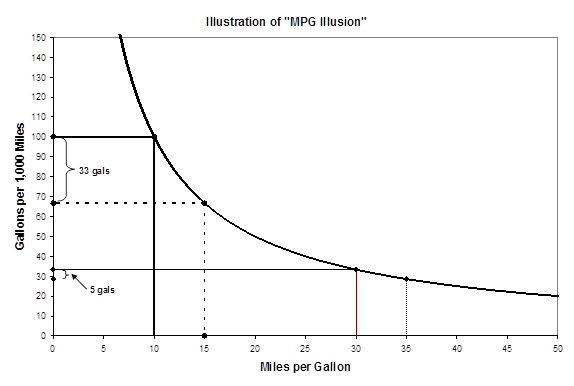Gasoline Vehicles Here's the New Dealership Label, Learn more about it:

1. Vehicle Technology & Fuel
The upper right corner of the label displays text and a related icon to identify it as a vehicle that is powered by gasoline. You will see different text and icons in the labels for other vehicles:- Diesel Vehicle
- Compressed Natural Gas Vehicle
- Hydrogen Fuel Cell Vehicle
- Flexible-Fuel Vehicle: Gasoline-Ethanol (E85)
- Plug-In Hybrid Vehicle: Electricity-Gasoline
- Electric Vehicle
2. Fuel Economy
For gasoline vehicles, the label shows City, Highway, and Combined MPG (miles per gallon) values. The Combined MPG value is the most prominent for the purpose of quick and easy comparison across vehicles. Some form of the miles per gallon metric has been on vehicle labels since 1977. Combined fuel economy is a weighted average of City and Highway MPG values that is calculated by weighting the City value by 55% and the Highway value by 45%.3. Comparing Fuel Economy to Other Vehicles
This text indicates the category of the vehicle (e.g., Small SUV, Station Wagon, Pickup Truck, etc.) and the best and worst fuel economy within that category for the given model year. There are nine car categories, six truck categories, and a “special purpose vehicle” category. These categories are used only for labeling and consumer information purposes and do not serve any other regulatory purpose. For each model year, EPA publishes lists identifying the best and worst fuel economy performers in each category available at http://www.epa.gov/fueleconomy/data.htm.- Fuel Economy Leaders
- Lowest Fuel Economy Models
- Highest Fuel Economy by Vehicle Class
- Lowest Fuel Economy by Vehicle Class
Note: for those vehicles that do not use liquid fuels--such as electric vehicles, plug-in hybrid electric vehicles operating on electricity, and compressed natural gas vehicles-- the labels display miles per gallon of gasoline-equivalent (MPGe). Think of this as being similar to MPG, but instead of presenting miles per gallon of the vehicle’s fuel type, it represents the number of miles the vehicle can go using a quantity of fuel with the same energy content as a gallon of gasoline. This allows a reasonable comparison between vehicles using different fuels. For example, you can use MPGe to compare a compressed natural gas (CNG) vehicle with a gasoline vehicle; even though CNG is not dispensed or burned in actual gallons.
4. You Save/Spend More over 5 Years Compared to Average Vehicle
The label shows the estimated fuel cost over a five-year period for the vehicle compared to the average new vehicle. If the vehicle would save the consumer money compared to the average vehicle, the label would state, “You save $x,xxx in fuel costs over 5 years compared to the average new vehicle.” If the vehicle would be more expensive to operate than the average vehicle, the label would state, “You spend $x,xxx more in fuel costs over 5 years compared to the average new vehicle.” These estimates are based on driving 15,000 miles per year, for five years, and the projected fuel price for the year ($3.70 per gallon of gasoline in this example). For more information on the source of projected fuel prices see “10. Details in Fine Print”.5. Fuel Consumption Rate
While a miles per gallon (MPG) estimate is a required feature that has appeared on the fuel economy label for several decades, this metric can be potentially misleading when consumers compare fuel economy improvements, particularly when they use it in place of fuel costs. The following chart shows the non-linear relationship between gallons used over a given distance and miles per gallon. The fuel savings, in gallons, for a vehicle that gets 10 MPG versus a vehicle that gets 15 MPG is about 33 gallons (assuming 1000 miles). On the other hand, the fuel savings in gallons, for the same 5 MPG fuel economy jump, for a 30 MPG versus a 35 MPG vehicle is only about 5 gallons.
This “MPG illusion” demonstrates why it may be more meaningful to express fuel efficiency in terms of consumption (e.g., gallons per mile or per 100 miles) rather than in terms of economy (miles per gallon). A fuel consumption metric allows for more accurate energy usage comparisons among vehicles.
The revised label includes both fuel economy and consumption information for all vehicle types.
6. Estimated Annual Fuel Cost
The annual fuel cost is based on two assumptions: an annual mileage of 15,000 miles and a projected gasoline price. For more information on the source of projected fuel prices see "Details in Fine Print”.7. Fuel Economy & Greenhouse Gas Rating
The new label assigns each vehicle a rating from 1 (worst) to 10 (best) for fuel economy and greenhouse gas (GHG) emissions (i.e., how much carbon dioxide the vehicle’s tailpipe emits each mile), as shown below. Consumers may note that higher fuel economy is associated with a better GHG emissions profile.| Rating | MPG | CO2 (g/mile) |
|---|---|---|
| 10 | 38+ | 0-236 |
| 9 | 31-37 | 237-290 |
| 8 | 27-30 | 291-334 |
| 7 | 23-26 | 335-394 |
| 6 | 22 | 395-412 |
| 5 | 19-21 | 413-479 |
| 4 | 17-18 | 480-538 |
| 3 | 15-16 | 539-612 |
| 2 | 13-14 | 613-710 |
| 1 | 0-12 | 711+ |
8. CO2 Emissions Information
This text provides three key pieces of information:Combined city/highway CO2 tailpipe emissions
The labeled vehicle’s CO2 tailpipe emissions are based on tested tailpipe CO2 emission rates. The rate of CO2 emissions is displayed in grams per mile.
Vehicle with lowest CO2 emissions
The label identifies the lowest tailpipe CO2 emissions of available vehicles. If there are electric or fuel cell vehicles on the market, which by definition have zero tailpipe emissions, this value will be zero grams per mile.
Learn more about emissions from the production of fuels at www.fueleconomy.gov
Driving your vehicle can yield both greenhouse gas (GHG) emissions from your vehicle's tailpipe and GHG emissions related to the production of the fuel used to power your vehicle. For example, activities associated with fuel production such as feedstock extraction, feedstock transport to a processing plant, and conversion of feedstock to motor fuel, as well as distribution of the motor fuel, can all produce GHG emissions.
The Fuel Economy and Environment Label provides a Greenhouse Gas Rating, from 1 (worst) to 10 (best), based on your vehicle's tailpipe carbon dioxide emissions only, and this rating does not reflect any GHG emissions associated with fuel production.
You can estimate the total GHG emissions that would be associated with driving an electric vehicle or plug-in hybrid electric vehicle, including GHG emissions from the production of electricity used to power the vehicle, with our greenhouse gas calculator.
9. Smog Rating
This is a rating for vehicle tailpipe emissions of those pollutants that cause smog and other local air pollution. This information, listed as “Smog” on the labels, will be displayed using a slider bar with a scale of 1 (worst) to 10 (best). The scale is based on the U.S. vehicle emissions standards, which incorporate specific thresholds for nitrogen oxide, non-methane organic gas, carbon monoxide, particulate matter, and formaldehyde. For those vehicles that run on electricity, the tailpipe emissions are zero.10. Details in Fine Print
This part of the label has a reminder that your fuel economy and emissions may be different due to a number of factors, such as how you drive and maintain your vehicle, how much you use air conditioning and other accessories, the weather, road conditions, how much the vehicle is loaded, and other factors. EPA periodically evaluates ways to improve our fuel economy estimates so they better reflect real-world driving. For more information on how your fuel economy can vary, or tips to improve your fuel economy, please see Gas Mileage Tips.This part of the label also details the assumptions that are used to determine the estimated annual fuel cost and the value used to compare 5-year costs to the average vehicle. EPA assumes annual mileage of 15,000 miles. The price of gasoline listed on new vehicle labels is based on projections from the U.S. Energy Information Administration for the applicable model year. It will typically be updated annually in coordination with the Department of Energy. Since EPA won't publish the fuel prices for 2013 model year labeling until 2012, the sample labels include an example price that is intended for illustrative purposes only.








